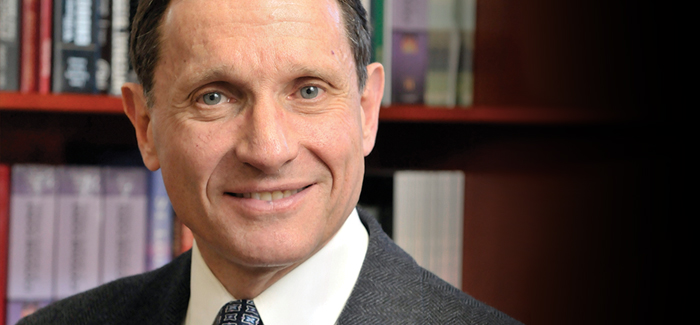
Kenneth S. Polonsky served on the UChicago faculty from 1981 to 1999, returning in 2010 as executive vice president and dean. (Photo courtesy the University of Chicago Medicine)
Kenneth S. Polonsky, executive vice president for medical affairs, defines the pillars that support the mission of the new Center for Care and Discovery.
Earlier this year, we opened the doors to the medical center’s new hospital pavilion, the Center for Care and Discovery (CCD). Completed on time and on budget, it has garnered much acclaim locally and nationally, and is, in many ways, a remarkable achievement.
From its founding, the University of Chicago Medicine has been committed to research, education, and patient care. To these three original pillars, we now add an equally important fourth: commitment to our community. The CCD rests securely on those four pillars.
One of the most modern clinical and surgical centers in the country, this new facility represents a significant investment not only in biomedicine but also in our city and state. The ten-story, 1.2 million-square-foot structure was built on an innovative grid design with repeating modular cubes that can be repurposed to accommodate future innovations. Silver LEED certified, the hospital includes integrated diagnostic and interventional platforms for complex specialty care and treatment of cancer, gastrointestinal disease, and neurological disorders, as well as large operating rooms for advanced surgery.
Yet as impressive as this leading-edge technology is, it does not overshadow the facility’s true focus, which is patient care. Our dedicated physicians and fellows care for patients in state-of-the-art single-occupancy rooms that accommodate family members for overnight stays and boast stunning views of Lake Michigan, Washington Park, and downtown Chicago.
In addition to being an engine for biomedical discovery, the new hospital has already had a positive economic impact on our community. Since its groundbreaking in 2009, the CCD initiative has brought more than 2,515 jobs to Illinois. Even more significantly, more than 40 percent of the construction contracts, representing over $270 million, were awarded to women- and minority-owned businesses. The construction of the CCD is the largest single health care investment in the history of both the University’s medical campus and Chicago’s South Side.
The vision of the CCD also has come to fruition amid many other exciting developments in the Biological Sciences Division (BSD). With recently recruited world-class faculty, we are adapting the statistical study of DNA sequence variation into high-speed computational algorithms designed to probe massive DNA sequencing data structures, electronic medical records, and advanced imaging data.
In the area of cancer, discoveries in the biological basis of tumor growth, metastasis, and drug-responsiveness are poised to unleash transformative advances in diagnostic testing, prevention, and therapeutic treatments. The University of Chicago Comprehensive Cancer Center supports physicians, clinical and basic research scientists, and trainees whose work is at the leading edge of cancer care and discovery.
The Division’s Center for Research Informatics (CRI), established in early 2011, has created a Clinical Research Data Warehouse, which currently contains data on 1.9 million patients and 7.6 million encounters over six years. The CRI’s Bioinformatics Core offers services and expertise that allow our basic, translational, and clinical investigators to conduct research more effectively than ever before.
Finally, we stand at the forefront of an initiative that will enhance our existing strengths in the field of neuroscience, strengths that span not only multiple departments in the BSD but also include the innovative work of colleagues from across the University. With the establishment of the Grossman Institute for Neuroscience, Quantitative Biology, and Human Behavior, we will create a novel interdisciplinary program to bring together neuroscience and behavior in the context of biological, environmental, and social interaction data while also harnessing the University’s long-standing eminence in evolution and genetics, statistics and computation, and economics.
As we look toward the future, we survey a landscape of collaborative, data-driven biomedicine, the education of a new generation of scientists and physicians, and continued dedication to patient care and our community in a new state-of-the-art hospital environment.
